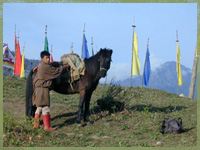 Bhutan
enters the 21st Century with an immense wealth of natural resources.
There are basically five reasons for this scenario: geographical
circumstance has bequeathed ecological, mineral and hydroelectric
riches; traditional resource management systems, underpinned
by Buddhist values, have encouraged long-term sustainable resource
use; a low population-land ratio has led to the current averting
of excessive grassroots resource pressure; delayed integration
within global processes, and gradual development thereafter,
has forestalled the plethora of modernizing pressures for resource
extraction; and government dedication to sustainability has
mitigated against the temptation for short-term economic gain.
The country therefore undertakes the ongoing challenge of sustainable
development with the considerable advantages of a relatively
uncompromised natural resource base, currently sustainable practices
and the strong commitment of government. Bhutan
enters the 21st Century with an immense wealth of natural resources.
There are basically five reasons for this scenario: geographical
circumstance has bequeathed ecological, mineral and hydroelectric
riches; traditional resource management systems, underpinned
by Buddhist values, have encouraged long-term sustainable resource
use; a low population-land ratio has led to the current averting
of excessive grassroots resource pressure; delayed integration
within global processes, and gradual development thereafter,
has forestalled the plethora of modernizing pressures for resource
extraction; and government dedication to sustainability has
mitigated against the temptation for short-term economic gain.
The country therefore undertakes the ongoing challenge of sustainable
development with the considerable advantages of a relatively
uncompromised natural resource base, currently sustainable practices
and the strong commitment of government.
Keenly aware of the current and future importance of environmental
conservation, and mindful of the potentially conflicting dynamics
of conservation and development, the government and its development
partners have introduced a set of environmental policies and
programmes that aim to preserve Bhutan's rich biodiversity
and guide the country on a sustainable development trajectory.
These include the nationalization of forest land in 1969,
the demarcation of 26% of total land as protected area, the
ruling by the National Assembly in 1995 that no less than
60% of land must be retained under forest cover at all times,
and the ongoing introduction of comprehensive environmental
legislation. In 1998 the National Environment Commission released
a National Environment Strategy for Bhutan, clarifying a development
path to minimize potentially negative environmental impacts.
The National Environment Strategy outlines three main avenues
for sustainable development - hydropower expansion, increased
self-sufficiency in food production, and industrial development
- all framed by concerns over environmental and cultural preservation.
It is noted that environmental degradation may occur in conditions
of extreme poverty, and in the exploitation of natural resources
for the generation of significant wealth. Furthermore, the
environment possesses economic, social, cultural and inherent
values, which may differ between social groups. The strategy
aims at pursuing a "Middle Path", understanding
that accomplishing goals within different sectors will involve
necessary compromises.
The state is to play a central role in the sustainable development
of the nation and in the regulation of the behavior of different
social groups. The cross-sectoral nature of environmental
issues and the need for an integrated approach towards resource
management is reflected in the responsibilities within individual
ministries for the sustainability of their development initiatives.
The majority of direct environmental policy aims at strengthening
the capabilities of government institutions and state-society
relations. Towards this end, five key cross-sectoral needs
are identified: (1) Information systems and research; (2)
Institutional development and popular participation; (3) Policies
and legislation; (4) Training and education; and (5) Monitoring,
evaluation and enforcement.
Past policies have placed an emphasis on top-down conservation
measures. However, whilst recognizing that such national level
policies and priorities are important in defining general
directions and broad parameters, it is the interaction of
humans with their respective environments at the grassroots
level that some of the most important and tangible dynamics
are in operation. As the margins narrow, with pressures from
both traditional and modern sectors, it will be increasingly
important to develop a participatory and representative style
of governance, refine the systems of environmental information
and analysis and promote continuing sustainability in resource
management institutional arrangements. Informed decisions
may then be effected which adequately represent popular environmental
values and successfully resolve potential conflicts. Solutions
will eventually depend on the form of future social pressures
and the nature of popular sentiment.
|



